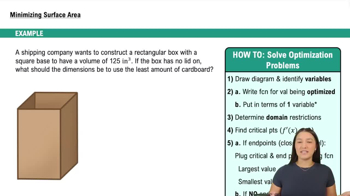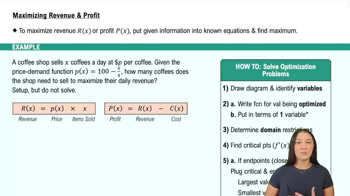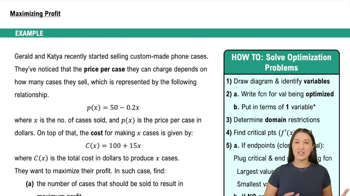Table of contents
- 0. Functions7h 52m
- Introduction to Functions16m
- Piecewise Functions10m
- Properties of Functions9m
- Common Functions1h 8m
- Transformations5m
- Combining Functions27m
- Exponent rules32m
- Exponential Functions28m
- Logarithmic Functions24m
- Properties of Logarithms34m
- Exponential & Logarithmic Equations35m
- Introduction to Trigonometric Functions38m
- Graphs of Trigonometric Functions44m
- Trigonometric Identities47m
- Inverse Trigonometric Functions48m
- 1. Limits and Continuity2h 2m
- 2. Intro to Derivatives1h 33m
- 3. Techniques of Differentiation3h 18m
- 4. Applications of Derivatives2h 38m
- 5. Graphical Applications of Derivatives6h 2m
- 6. Derivatives of Inverse, Exponential, & Logarithmic Functions2h 37m
- 7. Antiderivatives & Indefinite Integrals1h 26m
- 8. Definite Integrals3h 25m
5. Graphical Applications of Derivatives
Applied Optimization
Problem 4.5.70d
Textbook Question
Rectangles in triangles Find the dimensions and area of the rectangle of maximum area that can be inscribed in the following figures.
d. An arbitrary triangle with a given area A (The result applies to any triangle, but first consider triangles for which all the angles are less than or equal to 90° .)
 Verified step by step guidance
Verified step by step guidance1
Start by understanding that the maximum area of a rectangle inscribed in a triangle occurs when the rectangle's base is aligned with the triangle's base and its top vertices touch the triangle's sides.
Let the triangle have a base of length 'b' and a height 'h'. The area of the triangle can be expressed as A = (1/2) * b * h.
Define the dimensions of the rectangle as width 'x' and height 'y'. The area of the rectangle can be expressed as R = x * y.
Use similar triangles to express 'y' in terms of 'x'. For a given triangle, the height of the rectangle can be related to the height of the triangle based on the proportion of the base of the rectangle to the base of the triangle.
Set up the equation for the area of the rectangle R in terms of a single variable (either 'x' or 'y'), then take the derivative of R with respect to that variable, set the derivative equal to zero, and solve for the dimensions that maximize the area.
Recommended similar problem, with video answer:
 Verified Solution
Verified SolutionThis video solution was recommended by our tutors as helpful for the problem above
Video duration:
1mPlay a video:
Was this helpful?

 1:13m
1:13mWatch next
Master Intro to Applied Optimization: Maximizing Area with a bite sized video explanation from Callie
Start learningRelated Videos
Related Practice









